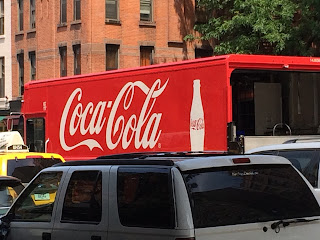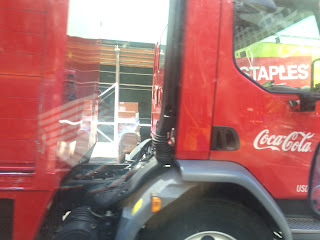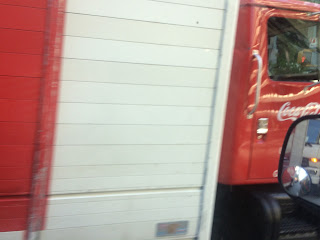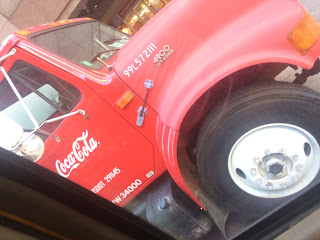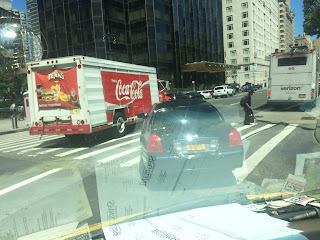Proposal # 3 B2210
Reproduction & Transformation: Broca-Brola Truck in New York City
• Project Title : Reproduction & Transformation: Broca-Brola Truck in New York City
• Abstract: An examination on a specific corporation’s power and influence in New York City. The art work challenges the corporation’s contribution to New York by transforming the corporation itself into an entirely different entity. A simulation of a positive corporate actor is documented. The corporation’s image and logo is modified and appropriated from source photography that is shot while driving around New York City.
The Coca-Cola truck is so omnipresent in New York City, that for most, it goes unnoticed. The ubiquity and ease of access to Coca-Cola does not happen by chance. It is a deliberate and methodical “campaign” to maximize profit at the expense of everyone else. The classic economic adage ‘demand creates supply’ is false. ‘Supply creates demand.’ The scale of Coca-Cola in New York City is rarely thought of, its effects are multiplicitous. This project transforms the Coca-Cola truck into a healthy vegetable distribution company called ‘Broca-Brola. Broca-Brola, unlike Coca-Cola is a good actor in society, bringing healthy food to the masses. The photographic simulation will document my point of view as a delivery driver in New York City. When I encounter Coca-Cola trucks, I take as many photographs as possible. This encounter is by chance, un planned, so the photographs are shot without composition and focus. Then these photos will be modified and transformed into Broca-Brola trucks. I will make the Broca-Brola trucks look realistic, yet not conceal that the images are originally from Coca-Cola trucks. Also important will be the description of the project which will re-write history and present Broca-Brola as a real company. The work will be presented in large scale photography; a series of 6 encounters will be documented with multiple photographs connected together to form single prints of each encounter.
• Background:
This work affirms my inclination to use art to suggest an alternative to the status quo. That alternative can be political, cultural, economic or social. I want to create such a solid case for the elimination of Coca-Cola from New York City that anyone who sees this art project will agree with me, even if they enjoy the beverage. This project also challenges the Pop Art depiction of Andy Warhol’s iconic ‘Coca-Cola’ image. His glamorization of that product enabled Coca-Cola to become ‘hip’ and perhaps gain cultural traction.
“All the cokes are the same and all the cokes are good.” -Andy Warhol
I maintain that Warhol was not critiquing Coca-Cola, but merely adding a layer of advertising to a product that should have been diminished and forgotten. This project also employs John Cage’s use of ‘chance operations’ as I never know when I will see the next Coca-Cola truck while driving, and when I do that is my cue to photograph. Rick Klotz is an artist who has transformed the logo of ‘Tide Detergent’ into ‘Freshjive’ for a t-shirt line. His art follows a similar path of appropriation.
• Work plan:
Photographs of Coca-Cola trucks are captured from Point of View of driver of van (me) when driving around New York City. Photographs are shot in rapid succession, both from fixed position (while stopped) and while driving (document’s movement). These photographs will be transferred to computer. Then in photoshop, individual photo’s from same encounter will be attached together as composite image. Each composite image will be altered to transform Coca-Cola truck into Broca-Brola truck. Each large scale composite photograph will be printed. Size of each photograph will be at least 24x30. Photos will be installed on wall in gallery, with project statement and large Broca-Brola logo above photographs.
• Significance of your project; what do you want to accomplish?
I would like to use this photography as part of an argument for a city wide initiative that calls for the banning of Coca-Cola from New York City. Erasing Coca-Cola from the city-scape through digital alteration of the landscape implies that Coca-Cola does not need to exist. Additionally, the photographs of the unaltered Coca-Cola trucks will be viewed as a web document, archiving my experience photographing these trucks. This project is influenced as well by the ‘political pop’ photography of Chinese artist Wang Guangyi. Guangyi takes iconic political images of Communist China and adds western pop cultural corporate logos. His work is about juxtaposition in society, while the ‘political pop’ of the Broca-Brola trucks suggests a rejection and alternative. 
• References or sources

















